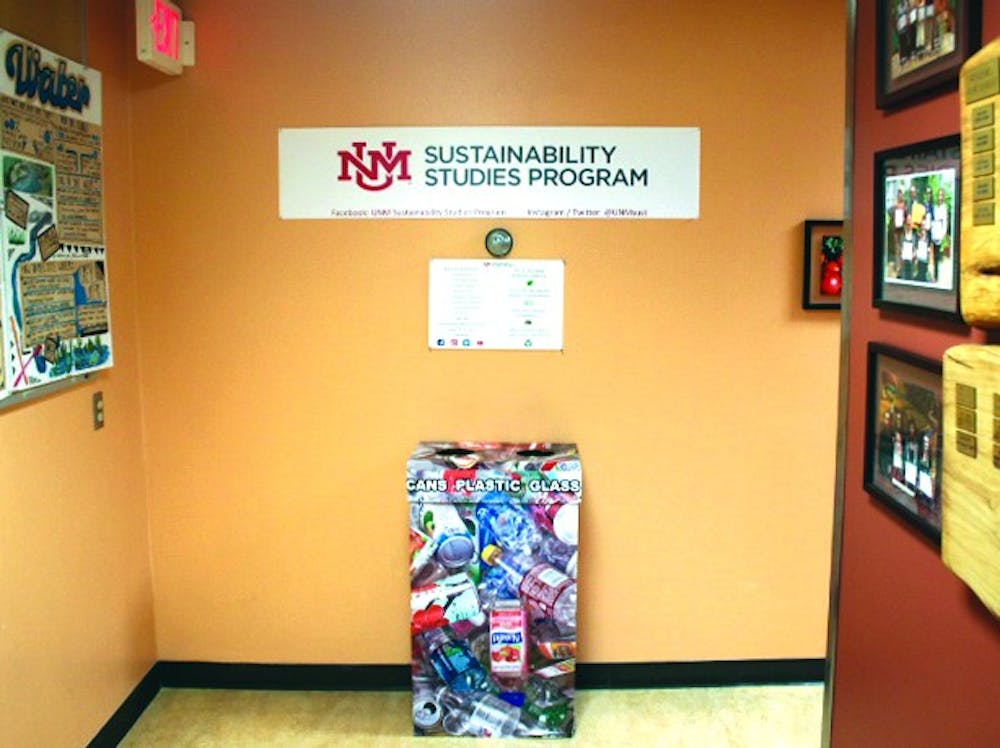Campus Sustainability Month is coming to an end, but efforts to make the University of New Mexico campus and the surrounding community more sustainable continue through the Sustainability Program at UNM.
In September of 2009, a Climate Action Plan (CAP) was created with the goal of making UNM 80% carbon neutral by the year 2030. The plan was never officially approved by the University but outlined goals and projects within the Sustainability Program.
Dr. Bruce Milne, director of the Sustainability Studies program, led a group of students in assisting in the creation of the CAP. The students created a report entitled "Carbon Neutrality at UNM."
According to the CAP, UNM’s electricity accounts for more than 41% of its carbon emissions. The plan suggested UNM utilize renewable energy for its electricity needs. One viable solution would be implementing solar panels on the roofs of existing buildings on UNM’s campus.
Milne said as far as he’s concerned, there has been very little progress made toward reaching the goals of students from 10 years ago.
"I mean, where are the solar panels? We have some that are in the yellow parking structure from 2009, but there is nothing more," Milne said.
The University was also unsuccessful in creating a purchase power agreement outlined in the CAP, where the University would buy power from a green power provider, according to Milne.
One student in Milne’s capstone independent study project class tried to critique the progress of the CAP and outlined who should be contacted and what updates should be made to make the goals a reality.
Milne said the reality of getting this project going toward its goals relies on the administrative side of things since it's difficult to pass on projects from different generations of students.
"It’s the kind of thing where some of these projects are perfect for handing off to the next students to keep the ball rolling, and that’s where that is right now," Milne said. "We just don’t have anything more to say about it. We’re not the physical plan, we don’t have the resources to do what they need to be doing."
UNM’s sustainability manager, Mary Clark, said they realized the program was not going to make the goals that students originally set in the CAP because they were not able to make changes to the transportation methods of getting students and staff to campus.
"While UNM was making significant improvements in energy usage reduction in the buildings and through our utility systems, we were not able to affect the transportation, and that is part of the (American College & University Presidents' Climate Commitment) requirement," Clark said.
Get content from The Daily Lobo delivered to your inbox
Clark said they have to be dealt with quickly and with full energy, because of quick turnarounds within the department and the amount of work that has to be done to get other sustainability programs running.
"There's too much to do in a one-person department, and it’s a campaign that we have to keep rolling out every year because students change, and we hire new faculty and staff," Clark said. "The campaign has to be really vigorous and consistent, and it’s very hard for one person to do that."
Despite the challenges faced within the department, all of the original projects outlined in the Climate Action Plan have been completed, plus more, according to Clark.
In 2006, the American College & University Presidents’ Climate Commitment (ACUPCC) was formed by twelve university presidents who believed higher education had the capacity and responsibility to lead climate change prevention and response as well as sustainability action.
ACUPCC was solely supported by Second Nature in 2011 and was eventually taken over by Second Nature. According to their website, Second Nature is committed to accelerating climate action in, and through, higher education.
Clark said UNM had to withdrawal from Second Nature in 2014, after the annual dues and reporting requirements increased significantly. Clark, who is the sole contributor to the Sustainability Management department, said she was not able to manage the reporting requirements.
Some of Clark’s goals for the near future include improving communication on campus about sustainability. She said she is currently putting together a sustainability communication plan.
Clark also said having people from within the sustainability department write out their ideas would be beneficial.
"I think those of us who all do the work, should we have some time, might want to sit down and see about putting (a plan) down on paper, but I’ve always thought that if students think something is a great idea, let's work together because this is a great way for students to learn how to make these things happen," Clark said.
The Office of Sustainability is no longer attempting to complete the goals outlined in the CAP, according to Clark, and so far no new concrete plans have been laid out.
Amanda Britt is the photo editor at the Daily Lobo. She can be contacted at photo@dailylobo.com or on Twitter @AmandaBritt__
Bianca Hoops is a beat reporter at the Daily Lobo. She can be contacted at news@dailylobo.com or on Twitter @bianca_hoops






